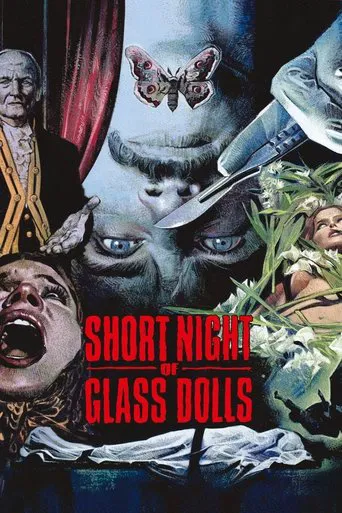

One suspects that in the grey nomansland between horror and giallo round about 1970 Euro producers began to suspect that they could get an audience by just tossing in a nude scene on top of even the most boring movies. In the world market then Euro must have meant nudity and they went with it. This movie is definitely one of those most boring movies. Its told as a kind of flashback by a detective in a state of catatonia. I never could figure out what was going on, and the pace is glacial, unrelieved even by Thulin showing a nipple now and then. Great shots of I think it is Prague, but not much else. Someone in production must have detected this because at the end they toss in an orgy of old Satanists reducing what looked menacing in Rosemarys Baby to wincing awfulness plus stilted sexual activity lifted from either of the comically dated orgies in either Emmanuelle in New York or Around the World, take you pick they're basically the same, though there is nothing hardcore here. Then it turns out that the aquiline figure lording over the satanic doings is also a doctor and he gets in the way of the main male lead getting well I wont give it away. Movie has a great title which made me grab for it, but it vanished into the non movie category while it was being watched. Not recommended.
... View MoreAfter the success of Mario Bava's "Blood and Black Lace", one thing was for certain: There was gold in them giallo films. Giallo, for the uninitiated, started as a series of pulpy crime novels from Italy, with the name stemming from the trademark yellow cover background. It wasn't until the 60's that movie versions came about, only to end up steering towards horror. With that, films like Argento's "The Bird With the Crystal Plumage", Antonio Margheriti's "Naked You Die", and Lucio Fulci's "Perversion Story" started popping up. Today, we look at one of the most celebrated titles in this sub-genre, Aldo Lado's* "Short Night of Glass Dolls." The dead body of Gregory Moore (Jean Sorel) is discovered. Or is he really dead? Throughout the movie, we hear his thoughts, as he must piece together the events that have lead to him laying on a steel table, motionless and unable to do anything. As he goes through a series of flashbacks, he soon starts to remember events that involved murder, madness and a girl named Mira (Barbara Bach), who has a strange obsession with butterflies.A unique twist on the sub-genre, "Short Night of Glass Dolls" is an expertly directed, shot, scored (by the one and only Ennio Morricone) and plotted murder mystery with occult overtones. Part of what stands out about it is that angle, which is strikingly unique, and adds an element of the fantastic to a genre that usually deals with human evil (though I could have done without the image of old people having sex.) Also notable is the lack of graphic violence on display. There's only one on screen murder, and it's somebody being pushed off a ledge. I quite like the fact that there's so little on screen mayhem, as it adds to the Hitchcock like plot and events.If there are any problems, it's in the ongoing narration from Gregory Moore. Usually, it works great, but there are moments (especially nearing the end) in which it get's annoying. Also, a minor complaint, but again, I really didn't need to see all those naked old people.Those are all minor complaints though, as "Short Night of Glass Dolls" is absolutely essential for fans of giallo films, especially for beginners and those wanting a unique spin on the genre. Highly recommended.
... View MoreWhat a pleasant surprise. This early giallo entry was Aldo Lado's first directorial feature and he put a lot of effort into it. What might disappoint slightly is that you don't see a lot in the way of good deaths. Most are done off-screen, which makes this a marginal giallo, at best. However, don't be put off by the "lack of hack." This movie has got the goods and delivers them.An American journalist, Gregory Moore played by Jean Sorel(who reminds me of Franco Nero a bit), is found at the beginning of the film lying in the grass and being menaced by a hungry crow. Gregory is believed to be dead and so is transported to the hospital. However, while there, the audience is privy to his inner dialogue which seems to prove he is very much alive. The examining doctors are befuddled by his lack of rigidity and other normal signs of recent death. Then we begin to move through flashbacks as Gregory tries to piece together how he got to the hospital and what occurred over the last few days. During the hospital sequence, there are some delicious moments of uncertainty where you wonder whether a possibly still-living Gregory will fall under the scalpel for an autopsy or will he wake up with is innards exposed? I especially liked the part where he was slipped into the cooler until the doctors decided what to do with him and then another body is placed on the rack above him. Super creepy.The flashback sequences are masterfully spun. Gregory searches desperately for his girlfriend, the pretty-from-the-right-angle Barbara Bach, who's gone missing. He and his journalist friends butt heads with the local police in Prague as they chase shadows in empty plazas and zig-zagging alleys. After putting a few pieces of the puzzle together, Gregory finds a club for lovers of classical music and believes Barbara and other women have met their fate at the hands of the occupants. What follows is a rather strange orgy of black mass rites and political potency. The ending is shocking. The hospital aspect of the plot is very similar to a Twilight Zone episode and also to a Stephen King short story(I doubt King saw this film, but he did say the TZ episode inspired him-which is admirable since it's practically identical---ah, the ability to be published for such nonsense, but I digress).Ennio Morricone provides the score. While Morricone is always good, the second film by Aldo Lado has a much better score written by Ennio.There is almost no bloodshed in this film and what you do see is mainly off-camera deaths. This is unusual for 70's horror/thrillers and it's a rare treat to just sit back and take in Lado's meticulous direction.
... View MoreAldo Lado's "La Corta Notte Delle Bambole Di Vetro" aka. "Short Night Of The Glass Dolls" of 1971 is a work of art in style and beauty that every fellow lover of Italian Horror cinema should see for its many ingenious aspects. Yet, I cannot deny that I was a tiny bit disappointed with this film, which I bought under the title "Malastrana" and which several fellow Giallo-enthusiasts had recommended to me as something absolutely unique. My expectations were high, and I also expected something quite different in the film. I was (miss)lead to believe that "Malastrana" was a typical Giallo, and while it can be attributed to the Giallo-genre, it can not really be described as a Giallo in the traditional sense. It was not the lack of stylish murders from the perspective of a black-gloved killer that bothered me, however. The visually striking film has a downright brilliant premise and an ingenious ending, but in-between it tends to drag a little. While the general atmosphere is an eerie one, however, I would have loved a little more genuine scares.Not that the film wasn't suspenseful. It actually builds up a great tension. The film begins very promising, when a man (Jean Sorel) is brought to a morgue while he is actually still alive. The man, who soon remembers that he is Gregory, an American Journalist working in Prague, experiences how he is pronounced dead, and yet he is unable to do anything about his situation. He therefore decides that all he can do is to try and remember how he got in this peculiar situation... A more than original beginning indeed, which made my expectations for the rest of the film even higher. A fellow Giallo fan had described the film as one of his personal favorites to me, and in the beginning I almost felt that it might become one of mine. Sadly, there are some points that I didn't like. The film drags a little in the middle, and the suspense could sometimes have been more intense. Also, the film does not really make the viewer care for the characters, which lessens the intensity a little. Then again, the film has many brilliant aspects. Visually, the film is incredibly striking. The photography is beautifully done and Prague is an excellent setting for a Giallo, even more for one with an occult twist. The visual impressions are intensified by a brilliant score by maestro Ennio Morricone. Jean Sorell is very good in the lead and the rest of the performances are also brilliant. The cast includes the great Mario Adorf in a typically unpolished role, and the immortal Ingrid Thulin. The ravishing Barbara Bach is unbelievably beautiful in the role of Mira, the main protagonist's young girlfriend who takes every man's breath away. Overall, "Short Night Of The Glass Dolls" did not quite live up to my very high expectations, but it is not the film alone which can be blamed for that. I began to watch this film expecting a masterpiece, and while, in my opinion, it is not, it is nonetheless a highly atmospheric, original and visually striking film that no Italian Horror fan should consider missing. Especially the ending is breathtaking. Not an absolute masterpiece, in my opinion, and yet highly recommended to all my fellow Giallo-buffs!
... View More